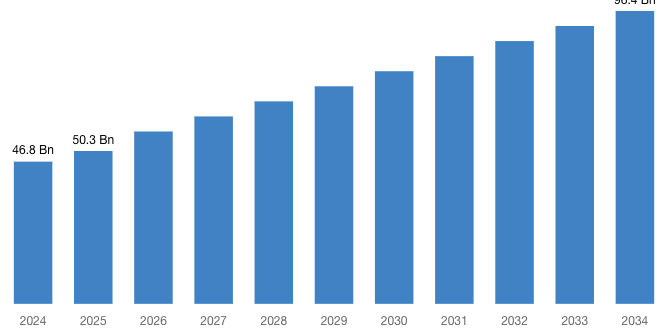Austin, TX, USA, Oct. 07, 2025 (GLOBE NEWSWIRE) — Custom Market Insights has published a new research report titled “Direct Reduced Iron Market Size, Trends and Insights By Product Type (Hot Briquetted Iron, Cold Direct Reduced Iron), By Technology (Gas Based, Coal Based), By Application (Steelmaking, Electric Arc Furnace, Basic Oxygen Furnace, Foundries, Others), By Industry Vertical (Construction, Automotive, Aerospace, Others), and By Region – Global Industry Overview, Statistical Data, Competitive Analysis, Share, Outlook, and Forecast 2025 – 2034“ in its research database.
“According to the latest research study, the global Direct Reduced Iron Market size and share were valued at approximately USD 46.8 billion in 2024, are expected to reach USD 50.3 billion in 2025, and are projected to grow to around USD 96.4 billion by 2034, with a compound annual growth rate (CAGR) of about 7.5% during the forecast period from 2025 to 2034.”
Click Here to Access a Free Sample Report of the Global Direct Reduced Iron Market @ https://www.custommarketinsights.com/request-for-free-sample/?reportid=74122
Overview
According to industry experts at CMI, Direct reduced iron (DRI), also known as sponge iron, is a solid form of metallic iron made by eliminating oxygen from iron ore at temperatures lower than its melting point. It is produced by a method known as direct reduction, which uses solid or gaseous reducing agents such as hydrogen and carbon monoxide to convert iron oxides to metallic iron without melting.
The resulting porous, sponge-like product is a valuable raw material for steel production, frequently substituting steel scrap. The direct reduced iron market is being driven by several factors, such as the growing steel industry, increasing investment in infrastructure development, and growing demand from end-use sectors such as automotive, aerospace and others. However, the shortage of feedstock and pellets hinders the industry’s growth during the analysis period.
Key Trends & Drivers
- Growing partnership among the market players: The rising partnership among the key market players is expected to foster the industry expansion over the forecast period. For instance, in April 2025, Clariant, a specialty chemical business focusing on sustainability, announced that it has maintained its successful partnership with Midrex and will increase collaboration in direct reduced iron (DRI) technology for steel manufacturing. Natural gas-based DRI is a low-carbon alternative to traditional coal-based ironmaking, using natural gas with recovered CO₂ and H₂O to produce reducing gas for the production process. The technique combines MIDREX® Reformers with Clariant-manufactured REFORMEX® Catalysts, which provide superior activity and stability while increasing productivity, lowering energy usage, and reducing carbon emissions. The MIDREX DRI method saves approximately one ton of CO₂ for every ton of basic steel.
Request a Customized Copy of the Direct Reduced Iron Market Report @ https://www.custommarketinsights.com/request-for-customization/?reportid=74122
- Incentives and policy support: There are many government policies and incentives around the world that enable the Direct Reduced Iron (DRI) sector to grow. One is making steel in a more eco-friendly, lower-carbon way. Governments grant tax breaks and incentives to induce people to invest in cleaner steelmaking that uses DRI, notably hydrogen-based DRI, which is frequently called “green DRI.” These financial incentives make it cheaper to get money for initiatives and make them more likely to succeed. For instance, the US and other countries offer tax breaks and other incentives to businesses that use green technologies to make clean steel. India and other nations have initiated significant government efforts to create green steel. These projects include concessional loans, risk assurances, and financial tools that will help both primary and secondary steel mills use DRI and green technologies. India’s Green Steel Mission, which costs ₹5,000 crore, intends to make a lot more steel in a way that is beneficial for the environment by 2050.
Report Scope
| Feature of the Report | Details |
| Market Size in 2025 | USD 50.3 Billion |
| Projected Market Size in 2034 | USD 96.4 Billion |
| Market Size in 2024 | USD 46.8 Billion |
| CAGR Growth Rate | 7.5% CAGR |
| Base Year | 2024 |
| Forecast Period | 2025-2034 |
| Key Segment | By Product Type, Technology, Application, Industry Vertical and Region |
| Report Coverage | Revenue Estimation and Forecast, Company Profile, Competitive Landscape, Growth Factors … |

